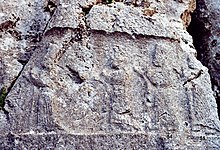Portal:Phoenicia
THE PHOENICIA PORTAL

Phoenicia (/fəˈnɪʃə, fəˈniːʃə/), or Phœnicia, was an ancient Semitic thalassocratic civilization originating in the coastal strip of the Levant region of the eastern Mediterranean, primarily located in modern Lebanon. The territory of the Phoenicians expanded and contracted throughout history, with the core of their culture stretching from Arwad in modern Syria to Mount Carmel in modern Israel covering the entire coast of modern Lebanon. Beyond their homeland, the Phoenicians extended through trade and colonization throughout the Mediterranean, from Cyprus to the Iberian Peninsula.
The Phoenicians directly succeeded the Bronze Age Canaanites, continuing their cultural traditions following the decline of most major cultures in the Late Bronze Age collapse and into the Iron Age without interruption. It is believed that they self-identified as Canaanites and referred to their land as Canaan, indicating a continuous cultural and geographical association. The name Phoenicia is an ancient Greek exonym that did not correspond precisely to a cohesive culture or society as it would have been understood natively. Therefore, the division between Canaanites and Phoenicians around 1200 BC is regarded as a modern and artificial division.
The Phoenicians, known for their prowess in trade, seafaring and navigation, dominated commerce across classical antiquity and developed an expansive maritime trade network lasting over a millennium. This network facilitated cultural exchanges among major cradles of civilization like Greece, Egypt, and Mesopotamia. The Phoenicians established colonies and trading posts across the Mediterranean; Carthage, a settlement in northwest Africa, became a major civilization in its own right in the seventh century BC.
The Phoenicians were organized in city-states, similar to those of ancient Greece, of which the most notable were Tyre, Sidon, and Byblos. Each city-state was politically independent, and there is no evidence the Phoenicians viewed themselves as a single nationality. While most city-states were governed by some form of kingship, merchant families likely exercised influence through oligarchies. After reaching its zenith in the ninth century BC, the Phoenician civilization in the eastern Mediterranean gradually declined due to external influences and conquests. Yet, their presence persisted in the central and western Mediterranean until the destruction of Carthage in the mid-second century BC. — Read more about Phoenicia, its mythology and language
 Featured article
•
Featured article
•
A Featured article represents some of the best content on Wikipedia
The Battle of Panormus was fought in Sicily in 250 BC during the First Punic War between a Roman army led by Lucius Caecilius Metellus and a Carthaginian force led by Hasdrubal, son of Hanno. The Roman force of two Roman and two allied legions defending the city of Panormus defeated the much larger Carthaginian army of 30,000 men and between 60 and 142 war elephants.
The war had commenced in 264 BC with Carthage in control of much of Sicily, where most of the fighting took place. In 256–255 BC the Romans attempted to strike at the city of Carthage in North Africa, but suffered a heavy defeat by a Carthaginian army strong in cavalry and elephants. When the focus of the war returned to Sicily, the Romans captured the large and important city of Panormus in 254 BC. Thereafter they avoided battle for fear of the war elephants which the Carthaginians had shipped to Sicily. In late summer 250 BC Hasdrubal led out his army to devastate the crops of the cities of Rome's allies. The Romans withdrew to Panormus and Hasdrubal pressed on to the city walls. (Full article...)Phoenician mythology •
Images
 Good article
•
Good article
•
A Good article meets a core set of high editorial standards
Phoenician inscriptions & language •
The Canaanite and Aramaic inscriptions, also known as Northwest Semitic inscriptions, are the primary extra-Biblical source for understanding of the society and history of the ancient Phoenicians, Hebrews and Arameans. Semitic inscriptions may occur on stone slabs, pottery ostraca, ornaments, and range from simple names to full texts. The older inscriptions form a Canaanite–Aramaic dialect continuum, exemplified by writings which scholars have struggled to fit into either category, such as the Stele of Zakkur and the Deir Alla Inscription.
The Northwest Semitic languages are a language group that contains the Aramaic language, as well as the Canaanite languages including Phoenician and Hebrew. (Full article...)Did you know (auto-generated) •

- ... that the discovery of Phoenician metal bowls in 1849 created the entire concept of Phoenician art?
- ... that archaeological excavations in the historic town of Kharayeb revealed a rural settlement with a complex system of cisterns and a Phoenician temple?
- ... that the deity of the Phoenician sanctuary of Kharayeb remains unidentified due to the absence of names of specific gods in unearthed inscriptions?
- ... that coins issued by Baalshillem II, the Phoenician king of Sidon, were the first Sidonian coins to bear minting dates corresponding to the king's year of reign?
- ... that the earliest-known Phoenician inscriptions were found near Bethlehem?
- ... that the sarcophagus of Eshmunazar II, the Phoenician king of Sidon, is one of only three ancient Egyptian sarcophagi unearthed outside Egypt?
Related portals
Categories
Wikiproject
Other Wikimedia and Wikiportals
The following Wikimedia Foundation sister projects provide more on this subject:
-
Commons
Free media repository -
Wikibooks
Free textbooks and manuals -
Wikidata
Free knowledge base -
Wikinews
Free-content news -
Wikiquote
Collection of quotations -
Wikisource
Free-content library -
Wikiversity
Free learning tools -
Wikivoyage
Free travel guide -
Wiktionary
Dictionary and thesaurus
Parent portal: Lebanon













































